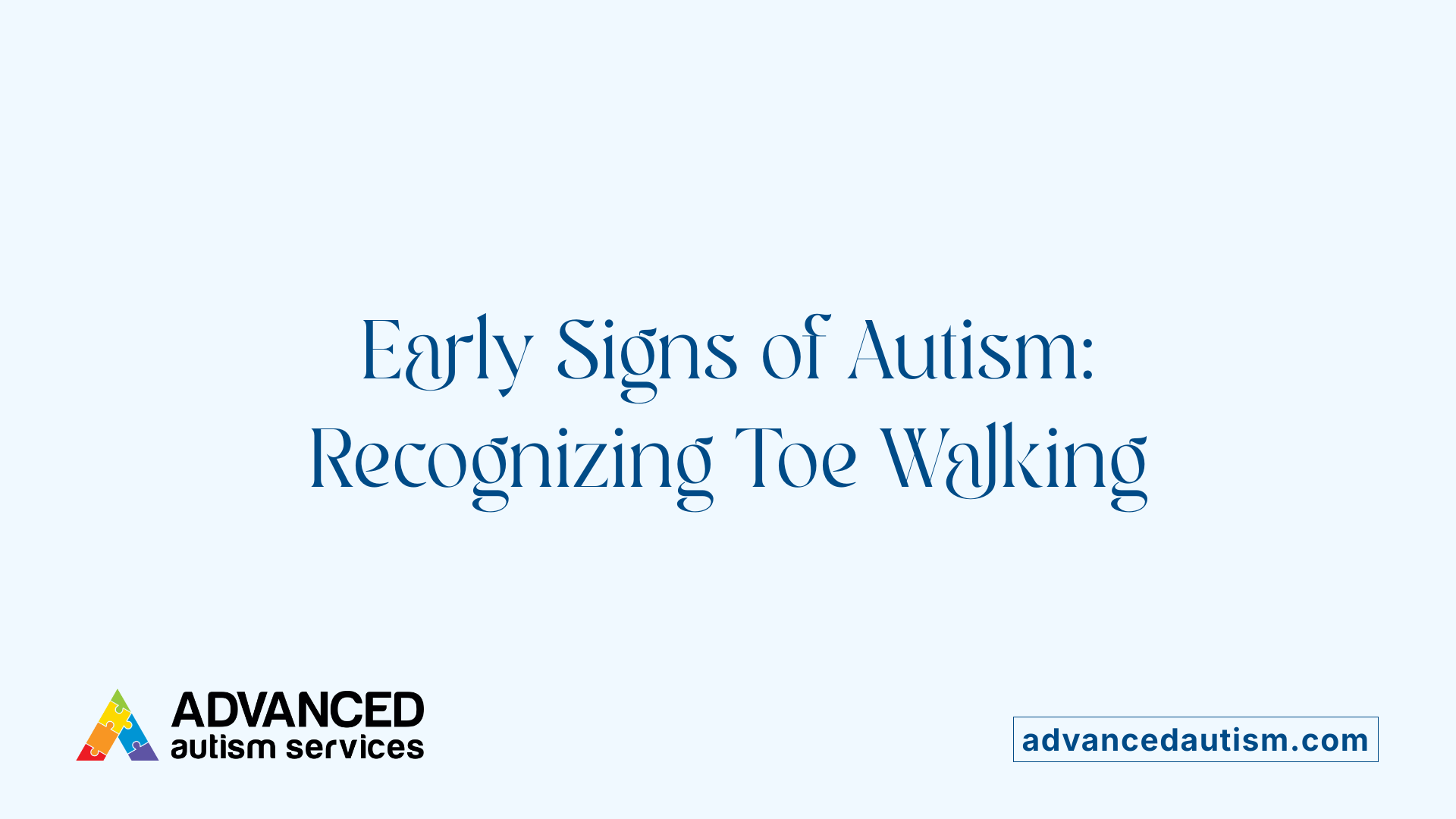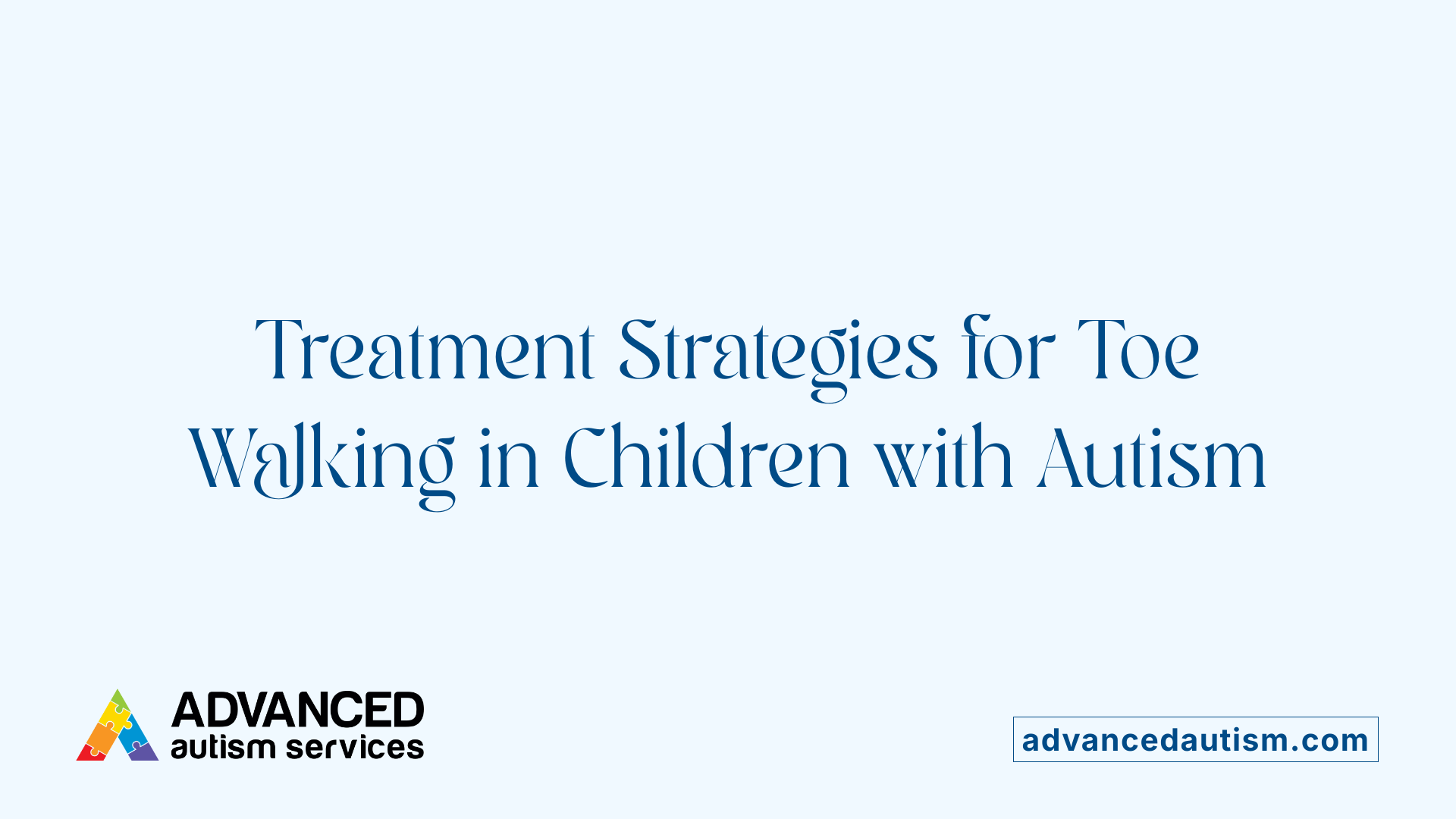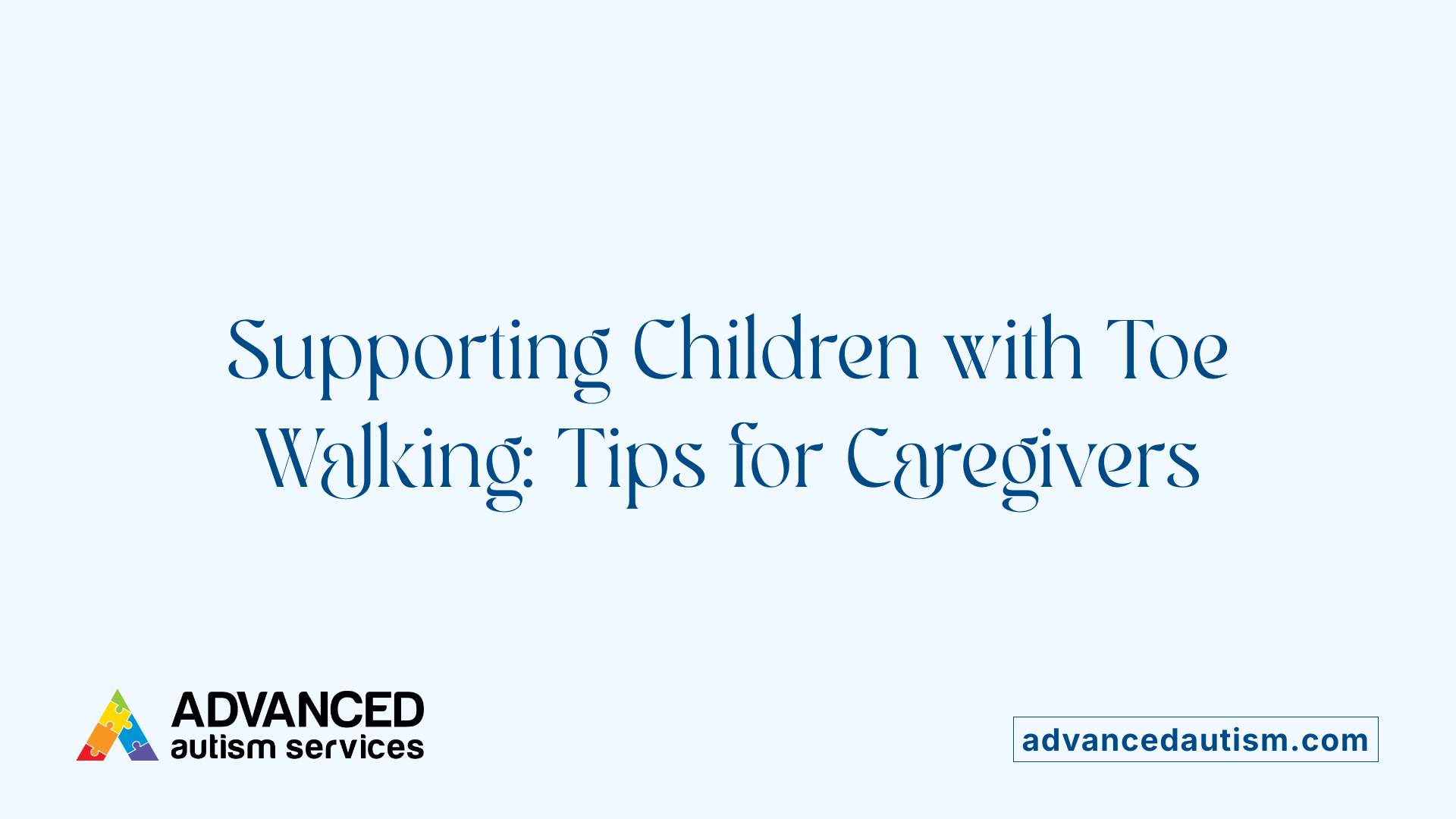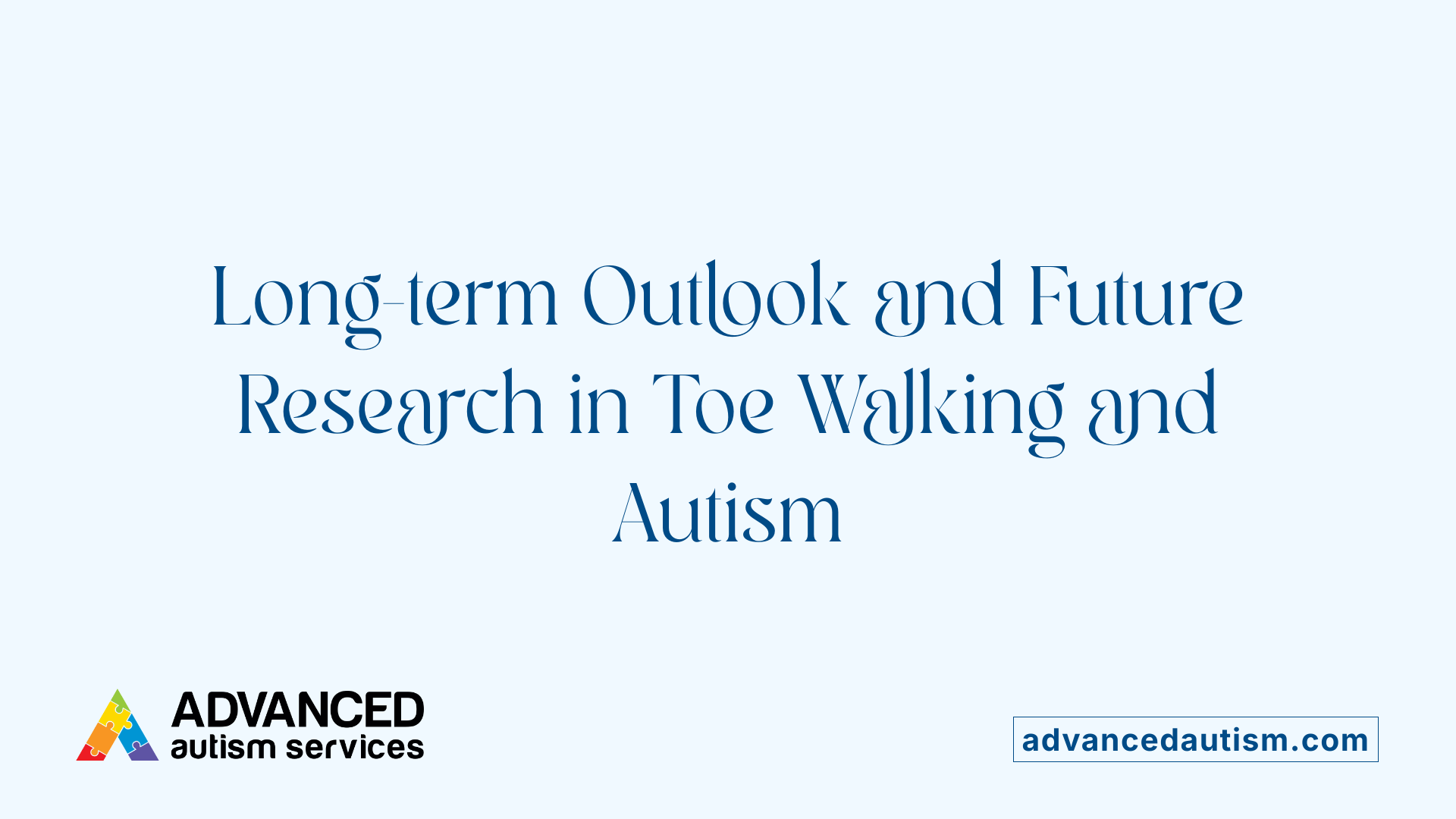Exploring a Common Gait Pattern in Early Childhood Development
Toe walking, or walking on the balls of the feet, is a common gait pattern observed in young children, especially during their early developmental stages. While most children outgrow this behavior by age 2 or 3, persistent toe walking beyond these years can be a sign of underlying conditions, including autism spectrum disorder (ASD). Recognizing the signs and understanding the potential significance of toe walking is crucial for early diagnosis and intervention, which can positively influence developmental outcomes.
Prevalence and Significance of Toe Walking in Children with Autism

How common is toe walking among children with autism?
Research indicates that a significant percentage of children with autism spectrum disorder (ASD) exhibit persistent toe walking. Studies show that approximately 6.3% to 9% of children with autism walk on their toes beyond the typical developmental period, compared to less than 0.5% of children without autism. For example, a 2019 large-scale review reported that about 8.4% of children with ASD diagnosed with persistent toe walking, highlighting how much more common this behavior is in autistic children. Additionally, among children with idiopathic toe walking—those without a clear physical or neurological cause—up to 20% are found to have autism.
How does this compare with typically developing children?
In contrast, toe walking in neurotypical children is quite common in early childhood, especially during toddlerhood. Most children outgrow it by age 2 or 3, with persistent toe walking being rare in children without neurological or musculoskeletal issues. Less than 0.5% of typically developing children continue toe walking beyond preschool age. The difference is stark; research shows that in children with ASD, the prevalence of toe walking can reach as high as 20%, making it a notable marker when evaluating developmental progress.
Why does persistent toe walking warrant attention?
While toe walking in young children is often harmless and part of normal development, its persistence beyond age 3 should prompt further investigation. Toe walking can be associated with underlying conditions such as cerebral palsy, muscular dystrophy, or neurodevelopmental disorders like autism.
In children with autism, toe walking may relate to sensory processing differences—such as hypersensitivity or hyposensitivity to touch, proprioception, or vestibular input. It may also stem from muscle tightness, motor planning delays, or neurological factors affecting gait and coordination.
Persistent toe walking can lead to biomechanical changes, including shortened Achilles tendons and calf muscles, which might hinder normal walking and cause long-term musculoskeletal problems if unaddressed. Early assessment by healthcare professionals—including pediatricians, neurologists, or physical therapists—is crucial to determine if therapy or other interventions are needed.
When should parents seek professional advice?
Parents should consult a healthcare professional if toe walking persists beyond age 2-3, especially when combined with other developmental signs like speech delays, social difficulties, or unusual behaviors. The presence of other indicators of autism or neurodevelopmental concerns increases the need for thorough evaluation.
Early intervention through physical therapy, sensory integration therapy, or behavioral strategies can support motor development, improve gait, and prevent physical complications. In some cases, medical or surgical treatments may be recommended, particularly if tight tendons or muscle abnormalities are involved.
Supporting children with toe walking
Supporting a child who toe walks involves patience and understanding. Developing motor skills through targeted therapies, creating supportive environments, and avoiding pressure are critical. Reinforcing positive progress, rather than focusing on gait correction alone, can foster children’s overall development.
In sum, while toe walking is common in early childhood, its persistence—especially in children with autism—warrants attention. Recognizing this early sign, along with other developmental cues, helps ensure timely evaluation and intervention, supporting healthy growth and development.
Neurodevelopmental Factors and Sensory Processing in Toe Walking

How does sensory processing difference impact toe walking in children with autism?
Many children with autism experience distinct sensory processing challenges, which can manifest as hypersensitivity (over-responsiveness) or hyposensitivity (under-responsiveness) to sensory stimuli. These differences can influence gait patterns such as toe walking. For example, a child who is hypersensitive to tactile input may avoid touching certain textures on the ground or prefer to walk on their toes to minimize contact with surfaces they perceive as uncomfortable. Conversely, hyposensitivity might lead a child to seek additional input through behaviors like toe walking, which provides proprioceptive feedback and helps them regulate their sensory environment.
Research shows that sensory system dysregulation—particularly involving touch, proprioception, and the vestibular system—is closely linked to toe walking in children with autism. Difficulties processing sensory information can lead children to adopt specific gait habits, including persistent toe walking, as a means of sensory regulation.
What are motor planning delays and how do they relate to muscle tone differences?
Children with autism often exhibit delays in motor planning—the process that enables the brain to conceive and execute a sequence of movements. These delays can make it challenging for a child to transition smoothly between different parts of the gait cycle, resulting in abnormal walking patterns like toe walking.
Alongside motor planning issues, differences in muscle tone are common. Hypotonia, or low muscle tone, is frequently observed in autistic individuals. It contributes to muscle weakness and joint instability, which can make standard heel-to-toe walking difficult. As a compensatory behavior or due to mechanical limitations, these children may walk on their toes, especially if their calf muscles or Achilles tendons are tight.
How are proprioception and tactile sensitivities connected to toe walking?
Proprioception, the sense that provides awareness of body position and movement, plays a significant role in gait and balance. Children with sensory processing differences may have impaired proprioceptive feedback, leading to perceptions of instability or discomfort during normal walking. As a result, toe walking can serve as a self-stimulatory behavior or a way to gain the needed sensory input.
Tactile sensitivities also influence walking behavior. Children who are overly sensitive to touch may avoid heel contact with the ground to lessen tactile input, resulting in persistent toe walking. Conversely, tactile hyposensitivity may prompt children to seek additional sensory input through toe walking.
What are the underlying causes of increased toe walking prevalence in children with autism?
Research consistently reports that children with autism are more likely to toe walk than neurotypical children. Studies reveal that approximately 8.4% of children with ASD demonstrate persistent toe walking, compared to less than 0.5% in typically developing peers. This prevalence is linked to various neurological and sensory factors.
The causes include tight calf muscles and Achilles tendons, which limit ankle dorsiflexion and promote toe walking. Sensory processing abnormalities—especially involving the vestibular system, which influences balance and spatial orientation—are also implicated. Dysfunction in the vestibular system may affect coordination and balance, leading children to adopt toe walking behaviors.
Furthermore, motor planning delays and primitive reflex retention contribute to abnormal gait patterns. Some theories suggest that toe walking might be a primitive or developmental motor pattern that persists in children with neurological differences.
What long-term effects can persistent toe walking have on children with autism?
Though some children naturally outgrow toe walking, persistent toe walking beyond age 3-4 may have physical and developmental implications. Continuous toe walking can lead to biomechanical changes, such as shortening or tightening of the Achilles tendons and calf muscles, which might cause issues with foot and ankle mobility later in life.
Long-term, this gait pattern could result in musculoskeletal discomfort or deformities if not addressed. However, current research indicates that for many children with autism, toe walking may be more of a behavioral or sensory regulation strategy than an immediate health concern. Nonetheless, ongoing observation and intervention are recommended to prevent potential physical issues and support normal gait development.
How do interventions help manage toe walking in children with autism?
Managing toe walking involves a combination of therapies tailored to the child's needs. Early intervention with physical therapy aims to improve muscle strength, flexibility, and motor planning skills. Sensory integration therapy can help children better process sensory inputs, reducing the reliance on toe walking behaviors.
In some cases, interventions include wearing orthotics, braces, or splints to support the ankle and promote heel contact during walking. Serial casting can increase ankle flexibility, and Botox injections may be used to relax tight calf muscles.
For persistent cases, surgical options such as lengthening procedures of the Achilles tendon might be considered, especially if gait abnormalities cause pain or limited mobility.
How important is early assessment and intervention?
When toe walking persists beyond age 3-4, especially if accompanied by other developmental challenges like speech delays or social difficulties, comprehensive evaluation by healthcare professionals is crucial. Pediatricians, neurologists, developmental specialists, and physical therapists can assess underlying causes and recommend appropriate treatments.
Early intervention significantly improves outcomes, helping children develop a more typical gait pattern, preventing musculoskeletal issues, and addressing any associated developmental delays.
How can caregivers support children with toe walking?
Supporting children involves fostering an environment that encourages normal motor development. Activities that promote strength, coordination, and flexibility are beneficial. It is essential to approach toe walking with patience and positive reinforcement, avoiding undue pressure that could increase anxiety or resistance.
Educating caregivers about the potential sensory and neurological roots of toe walking helps in understanding and supporting the child's needs. Creating understanding environments and providing sensory-friendly tools or therapies can make a significant difference.
| Aspect | Details | Additional Info |
|---|---|---|
| Prevalence in ASD | About 8-9% show persistent toe walking | Higher than in neurotypical children (<0.5%) |
| Causes | Sensory processing issues, tight muscles, motor delays | Involves tactile, proprioceptive, vestibular systems |
| Treatments | Physical therapy, orthotics, surgery | Effectiveness varies depending on case |
| Long-term effects | Potential for biomechanical changes | Usually manageable with early intervention |
| Associated signs | Language delays, repetitive behaviors | Often co-occurring with other ASD symptoms |
Understanding the Connection: Toe Walking as an Early Sign of Autism

What are the signs of autism in young children, including developmental or physical indicators like toe walking?
Recognizing autism in young children involves observing a variety of developmental and behavioral patterns. Common signs include delays in speech and language development, such as limited babbling or failure to respond to their name. Children may also have difficulty understanding simple instructions or engaging in typical play behaviors.
Social interactions often show differences, including avoiding eye contact, not smiling reciprocally, and showing little interest in peer play. Repetitive behaviors, such as hand-flapping, rocking, lining up toys, or fixating on specific routines, are also typical.
Physical signs can provide additional clues. Toe walking, where a child walks primarily on the toes or balls of the feet without heel contact, is more frequently observed in children with autism. Sensory sensitivities—being bothered by loud noises, bright lights, or certain textures—also commonly accompany these signs.
Early indicators often emerge within the first 1-2 years of life, underscoring the importance of developmental monitoring during this period. Recognizing these signs promptly can lead to earlier diagnosis and intervention, which significantly benefits developmental outcomes.
Clinical and Therapeutic Considerations for Toe Walking in Autism

What treatment options are available for toe walking in children with autism?
Treating toe walking in children with autism involves a multifaceted approach. Physical therapy is often the first line of intervention, focusing on stretching and strengthening exercises to improve ankle flexibility and promote a heel-to-toe gait. Sensory integration therapy may be incorporated to address sensory processing differences, aiming to balance tactile, proprioceptive, and vestibular sensitivities.
Orthotic devices, such as braces or splints, can help maintain correct foot positioning and prevent contractures. Behavioral strategies, including consistent reinforcement of flat-footed walking, support motor development and help establish typical gait patterns.
In some cases, medical procedures like serial casting or Botox injections are used. Serial casting involves applying a series of casts to gradually stretch tight tendons, especially the Achilles tendon. Botox injections temporarily weaken calf muscles, reducing tightness and allowing for easier stretching.
For severe or persistent cases, especially in older children, surgical options such as Achilles tendon lengthening or calf muscle lengthening may be considered. Surgery aims to correct structural abnormalities and improve mobility.
Early intervention is crucial in preventing long-term musculoskeletal problems, such as shortened tendons or deformities, and in supporting the development of a typical walking pattern.
When is medical or surgical intervention recommended for persistent toe walking?
Medical or surgical treatments are generally recommended when toe walking continues beyond age 4 or if it is linked with other developmental delays or physical abnormalities. Persistent toe walking that impairs mobility, causes pain, or leads to deformities like tight Achilles tendons often warrants more aggressive intervention.
In children with autism, persistent toe walking may also be associated with sensory processing differences or hypotonia, making intervention more necessary to prevent secondary issues.
A comprehensive assessment by a multidisciplinary team—including pediatricians, neurologists, orthopedic specialists, and physical therapists—is essential to determine the most suitable approach. This team evaluates the severity of toe walking, underlying muscle or nerve involvement, and the child's overall developmental status.
In cases where conservative measures have failed, options such as orthotic devices, serial casting, or surgery are considered. Surgical procedures are typically reserved for older children when the deformity is fixed or significantly impacting function.
In summary, early detection and tailored intervention strategies can effectively manage toe walking, helping improve gait and prevent long-term musculoskeletal complications. A multidisciplinary approach ensures that treatment is appropriate to the child's specific needs and developmental context.
Supporting Children with Toe Walking and Autism Spectrum Disorder

How can parents and caregivers support a child with toe walking, especially if connected to autism?
Supporting children who exhibit toe walking, particularly when associated with autism, requires a compassionate and informed approach. Early intervention is crucial. Parents can encourage motor development by engaging in gentle exercises and physical therapy designed to improve muscle flexibility, strength, and coordination. Collaborating with pediatric physical therapists or occupational therapists can provide personalized strategies tailored to each child's needs.
Positive reinforcement plays a vital role. Praising efforts and progress, no matter how small, fosters motivation and confidence. Using visual aids, social stories, or reward systems can help children stay motivated and feel supported throughout their developmental journey.
Creating an environment that supports sensory regulation is also beneficial. Children with autism often have sensory sensitivities, so providing a sensory-friendly space—such as calming textures, appropriate lighting, and quiet areas—can help. Furthermore, understanding and accepting sensory differences reduces anxiety related to walking or movement behaviors.
Patience and avoiding undue pressure are essential. Forcing a child to walk a certain way can lead to frustration or negative associations with mobility exercises. Instead, caregivers should focus on gentle encouragement and celebrating small successes.
Educating caregivers about autism-related sensory processing challenges helps in understanding the behaviors and reactions of children with ASD. When necessary, early assessment and intervention are encouraged to address gait issues and associated developmental concerns promptly, improving long-term outcomes.
Long-term Implications and Future Directions in the Study of Toe Walking and Autism

What are the long-term effects of persistent toe walking in children with autism?
Persistent toe walking in children with autism may have several long-term implications, although full understanding remains incomplete. One of the primary concerns is the potential for biomechanical changes over time. Specifically, toe walking can lead to the shortening of the Achilles tendons and calf muscles, which may impair normal foot and ankle mobility in adulthood.
Additionally, continued toe walking without intervention could cause alterations in gait patterns and joint alignment, potentially leading to discomfort or musculoskeletal abnormalities later in life.
Some research suggests that in many cases, toe walking might be merely cosmetic or benign if it occurs in the absence of other neurological or muscular issues. However, studies indicate that untreated or persistent toe walking can increase the risk of musculoskeletal problems, including ankle instability or deformities.
Overall, early assessment and intervention are critical to prevent possible long-term physical issues and ensure optimal mobility in adulthood.
What are future directions for research in the link between toe walking and autism?
Advancing our understanding of toe walking in autism requires targeted research in several areas. Future studies aim to elucidate the neurodevelopmental mechanisms that contribute to this gait pattern, focusing on brain and sensory system functioning.
One promising avenue is the use of advanced imaging techniques to explore structural and functional differences in the brains of children with autism who toe walk. These insights could help clarify whether toe walking is linked to primitive reflex persistence, sensory processing anomalies, or motor planning deficits.
There is also a need for more refined diagnostic markers that can identify children at risk for persistent toe walking early in development. Such markers could facilitate earlier interventions, potentially reducing long-term risks.
Interventions themselves are another area ripe for innovation. Researchers are exploring combined sensory integration therapies, neuromodulation, and even genetic approaches to customize treatment plans based on individual profiles.
Emerging technologies like gait analysis and wearable sensors are improving the ability to monitor gait changes over time, allowing for more precise evaluation of intervention outcomes.
Ultimately, understanding the causal pathways and developing personalized treatment strategies could significantly improve functional outcomes for children with autism exhibiting toe walking.
Biomechanical and musculoskeletal risks
| Risk Type | Description | Potential Consequences |
|---|---|---|
| Tendon Shortening | Toe walking can lead to shortened Achilles tendons if untreated | Restricted ankle movement, deformity |
| Joint Misalignment | Abnormal gait may cause joint wear or misalignment | Pain, mobility issues |
| Muscle Imbalance | Overuse of certain muscle groups | Postural problems |
| Long-term Deformities | Persistent gait abnormalities | Chronic foot and ankle conditions |
Research needs and gaps
- Clarification of neurobiological mechanisms underlying toe walking in autism
- Longitudinal studies assessing physical and functional outcomes
- Development of early diagnostic tools
- Personalized intervention strategies
- Integration of new technologies for gait assessment
Potential for improved intervention methods
Innovations can include targeted sensory integration therapies, minimally invasive surgical options, and advanced orthotics. Combining behavioral, physical, and technological approaches promises to improve outcomes and prevent musculoskeletal complications.
| Intervention Method | Description | Advantages |
|---|---|---|
| Physical Therapy | Gait training, stretching | Improves flexibility, gait quality |
| Sensory Integration | Sensory processing therapy | Addresses sensory contributors |
| Orthotic Devices | Braces, splints | Supportive correction, prevention |
| Surgical Options | Tendon lengthening | Corrects biomechanical issues |
| Emerging Technologies | Wearable sensors, virtual reality | Monitoring, engaging therapy |
This growing body of research and technological development highlights the importance of early, tailored intervention strategies and the potential to improve both functional mobility and quality of life for children with autism.
Early Detection and Intervention Make a Difference
Recognizing toe walking as a potential early indicator of autism spectrum disorder underscores the importance of attentive developmental monitoring. While not every child who walks on their toes has autism, persistent toe walking beyond age 2-3, especially when accompanied by other signs such as speech delays, social challenges, or sensory sensitivities, warrants professional evaluation. Early intervention through therapies like physical and sensory integration therapy can significantly improve mobility and support developmental progress. Parents and caregivers play a vital role by fostering supportive environments, advocating for assessments, and partnering with healthcare professionals to ensure timely care. Understanding the links between gait patterns and neurodevelopmental conditions can facilitate earlier diagnosis, personalized interventions, and ultimately better outcomes for children.
References
- Walking on Tiptoes: Sign of Autism or Normal Development?
- Does Autism Cause Walking On Your Toes? - Healthline
- Toe walking in children - Symptoms & causes - Mayo Clinic
- Understanding Toe Walking and Autism
- What is Toe Walking? - Autism Research Institute
- Why Do Children with Autism Walk on Their Toes?
- Toe Walking and ASD: What's the Connection? - Psych Central
- Autism and toe-walking: are they related? Trends and treatment ...
- Toe walking in children and adolescents with Autism Spectrum ...
- Toe Walking: Symptoms, Causes & Treatment - Cleveland Clinic



